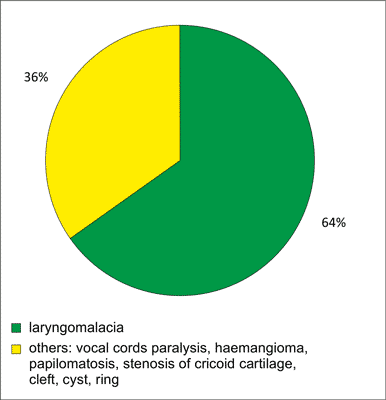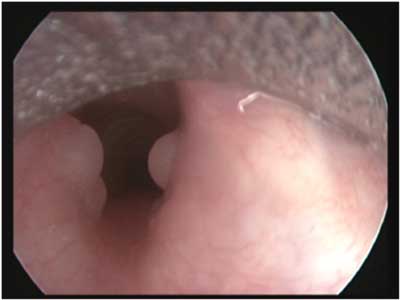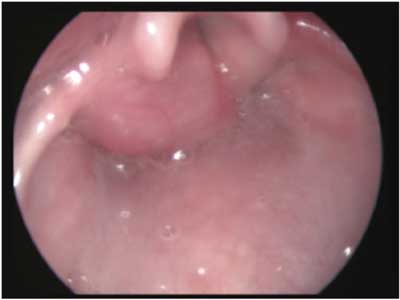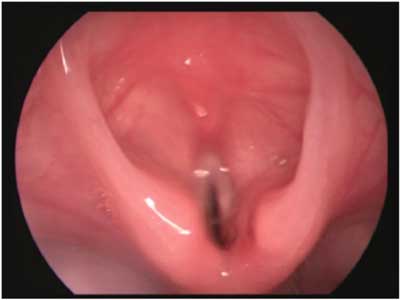© Borgis - New Medicine 4/2013, s. 120-122
Monika Jabłońska-Jesionowska, *Lidia Zawadzka-Głos
Congenital respiratory stridor in children
Department of Pediatric Otolaryngology, Medical University of Warsaw, Poland
Head of Department: Lidia Zawadzka-Głos, MD, PhD
Summary
Introduction. Respiratory stridor is a clinical symptom. This is the sound arised when air flows through narrowed airways and always showsimpairmentof airways patency. The narrowing of the airways may result from the pathology in their interior or from outside pressure.
Aim. The aim of this study is to analyze the congenital respiratory stridor in children.
Material and methods. In the Department of Pediatric Otolaryngology, Medical University of Warsaw in the period 2010-2013, 133 children were hospitalized because of an congenital respiratory stridor. During the clinical investigation following tests were made: chest X-ray, larynx ultrasound andcranial ultrasound, barium esophagography, ECG and echocardiography, laryngotracheoscopy, chest angio-CT, neurological and cardiological consultation.
Results. There were found: 3 cases of laryngeal cleft in I degree, haemangioma of the larynx in 5 cases, congenital paralysis of the vocal foldsin 4, laryngeal papillomatosis in 1, congenital stenosis of the cricoid cartilage in 6, laryngeal cyst in 5, vascular ring in 25, laryngomalacia in 85 cases. The clinical symptoms presented by children were: respiratory stridor, dyspnea during exercise, silent cry, sleepapnea, cyanosis, dysphagia, recurrentairway infections. The age of diagnosed children ranged from 1 week to 16 years.
Conclusions. 1. The laryngomalacia is not only one casue of congenital respiratory stridor. 2. Every congenital respiratory stridor is an indication for interdisciplinary investigation. 3. The standard procedure in the investigation of congenital stridor is endoscopy of larynx, trachea and bronchi. 4. Many disorders, which causes congenital respiratory stridor can and should be treated, with effect of relief of respiratory symptoms.
INTRODUCTION
Respiratory stridor is a clinical symptom but not a disease. This is the sound arised when air flows through narrowed airways. Ithas never been found in normal conditions. Stridor shows pathologicalimpairment in patency of airway. The pathology in larynx at the glottis generates inspiratory stridor, in subglottis area and in trachea inspiratory-expiratorystridor (1). Airway narrowing may be due to the pathology in their interior, or due to external pressure. The most common cause of congenital respiratory stridoris laryngomalaciacalled asflaccidity of the larynx (2), rarely congenital vocal cord paralysis and congenital stenosis of the cricoid cartilage. Symptoms include: stridor, apnea, dysphonia, dysphagia, choking, recurrent airway infections, chronic cough (3).
AIM
The aim of this study is to analyze the congenital respiratory stridor in children.
MATERIAL AND METODS
In the Department of Pediatric Otolaryngology, Medical University of Warsaw in 2010-2013 133 children were hospitalized because of an congenital respiratory stridor. In all 133 children detailed perinatal anamnesisand pediatric examination were done, chest X-ray, than the cranial-ultrasound for neurological assessment and ultrasound of larynx for evaluation ofthe mobility of the vocal cords has been made. In children with abdominal symptoms barium esophagography and ultrasound of abdomen were performed. ECG and echocardiography were performed in cases where the heart murmur was listened or abnormal chest X-ray was described. In each case, the decisive test waslaryngotracheoscopy under general anesthesia using a rigid bronchoscope size appropriate to the age of the patient. In some chest angio-CT scan were performed.
RESULTS
133 children were hospitalized because of an congenital respiratory stridor. It was inspiratory or mixted inspiratory- expiratory stridor. In infants the additional symptoms were observed due to pressure on airways: apnea with decrease in saturation, silent cry, cyanosis, and paroxysmal cough. The older children (several years old) presented effort dyspnoea, chest pain, decreased exercise tolerance, chronic cough and in those children also recurrent pneumonias and infections of larynx were diagnosed. Many children suffered from: choking, sialorrhea and lack of weight gain. The age of diagnosed children ranged from 1 week to 16 years. The children with permanent respiratory stridor or with silent cry were diagnosed in first weeks of their life. After that in 133 children with congenital respiratory stridor following disorders were diagnosed: cyst of the larynx in 5 cases (fig. 2), haemangioma of the larynx in 5 cases, congenital stenosis of the cricoid cartilage in 6 children (fig. 3), congenital vocal cords paralysis in 4 children (fig. 4), laryngeal cleft in first degreein 3 children, laryngeal papillomatosis in 1 child, vascular ring in 25 cases andcongenital flaccidity of the larynx in 82 children (fig. 1). Cyst of the larynx and laryngeal web were treated endosopic. In the case of vocal cords paralysis procedure of vocal cords lateralization after tracheostomywas performer (6). Haemangiomas of the larynx were treated with oral beta-blocker to give the involution changes within five months from beginning of the treatment. The children with vascular abnormalities of the great vessels were directed to further and deeper cardiological examination. The assessmentthe grade of airway’s compression during endoscopy was the one of the criteria for cardiosurgery in this children.

Fig. 1. The causes of congenital respiratory stridor.

Fig. 2. Cysts.

Fig. 3. Haemangiomalaryngis.

Fig. 4. Vocal cords paralysis.
CONCLUSIONS
Not every congenital respiratory stridor is caused by laryngomalacia. Out of 133 children who have been reportedto the ENT Department because of stridor, 82 i.e. 62% had congenital faccidity of the larynx (laryngomalacia), which resolves spontaneously in about 1.5 years old. In the remaining 51 children i.e. 48% otherlaryngeal and non-laryngeal causes of stridor were found required an appropriate treatment. Every congenital respiratory stridor in children requires a multidisciplinary investigation. In addition to laryngological this cases need the cardiological examination of congenital cardiovascular abnormalities and neurological to exclude diseases of the central and peripheral nervous system. Lack of investigation based on the assumption that the majority of congenital respiratory stridor are caused by laryngomalacia that resolves spontaneously or implementation this investigationon the later stage, deprive children of normal development opportunities and exposes to the development of complications (4). Many disorders, which causes congenital respiratory stridor can and should be treated, with effect of relief of respiratory symptoms.
Piśmiennictwo
1. Zawadzka-Głos L, Zając B, Chmielik M: Stridor krtaniowy u dzieci. Magazyn Otolaryngologiczny 2005; suppl VII, 15-21. 2. Zawadzka-Głos L, Zając B, Chmielik M, Badełek-Izdebska M: Zwężenie podgłośniowe krtani w aspekcie praktycznym. Nowa Pediatria 2005;3: 105-107. 3. Koichi Sakakura: Congenital laryngeal anomalie presenting as chronic stridor: A retrospective study of 55 patients. Aurisnasus larynx 2008; 35 (4): 527-533. 4. Sichel JY, Dangoor E, Eliashar R, Halperin D: Management of congenital laryngeal malformations. Am Journal of Otolaryngology 2000; 21(1): 22-30. 5. Botema M, Kishore A, Kubba H, Geddes E: The role of fibreopticlaryngoskopy In infants with stridor. Int Journal of Pediatric Otorhinolaryngology 2000; 55 (15): 17-20. 6. Zawadzka-Głos L, Frąckiewicz M, Chmielik M: Endoscopic laterofixations in bilateral ocal cord paralisis in children. Int Jour Pediatr Otorhinolatyngol 2010; 74(6): 601-603.



